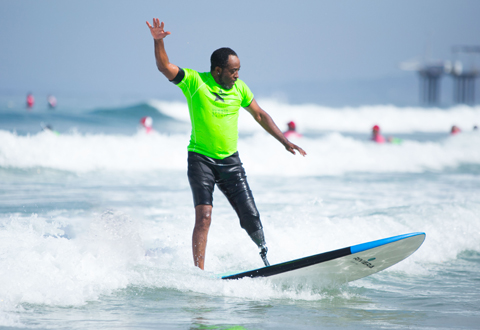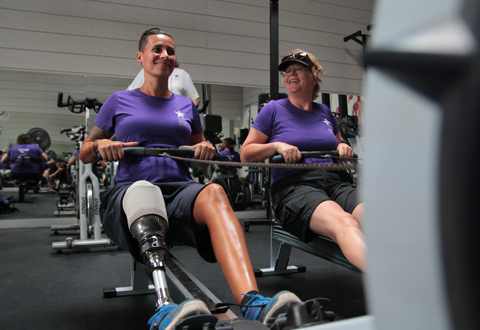4000 and Counting

Modern prosthetics enhance mobility and functionality to such an extent that surfing, skiing, snorkeling, and even water skiing are now possible.
When you hear the word “prosthetic”, your first thought might be of an artificial limb. But high-tech arms and legs are just a small portion of VA’s 4000-item prosthetic inventory, including devices to assist Veterans with mobility, enhance senses such as hearing, and make living spaces more convenient and user-friendly. In fiscal year 2014, VISN 5 spent over $60 million on more than 263,000 prosthetic and sensory aid items prescribed to patients. If you have a need for an assistive item, VA has a solution.
Starting Small
Hearing aids, one of the most prescribed items the VA provides to patients, range in size from tiny completely-in-canal models to open-fit ones, allowing low frequency sound to enter the ear naturally while high-frequency sounds are amplified. VISN 5 fills over 11,500 prescriptions for hearing aids and related components each year, while also managing the repairs of malfunctioning devices in its facilities’ Audiology departments.
Other often-dispensed items include walkers and eyeglasses—VISN 5’s providers fabricate over 30,800 pairs of glasses annually.Out of Body Devices
A major category of prosthetics includes items that are designed for homes, automobiles, and offices. Computer keyboards are one example: Nowadays typing aids, large text, one-handed, and Braille keyboards are available, as well as voice recognition software that lets Veterans “type” by talking.
Dozens of auto devices are available to help keep Veterans mobile. In the car, extenders increase leverage for turning keys in auto ignitions or doors, and other devices act as handles. Swiveling seat cushions and leg lift straps (which allow people to use their upper-body strength) assist drivers and passengers to get in and out of vehicles. Hand controls and brake pedal extensions help with steering, stopping, and accelerating, while panoramic, or convex, mirrors reduce blind spots for people with neck or spinal restrictions.
Prosthetic devices for the home include ramps, door openers, beds, and specialized kitchen utensils, counters, and appliances. Bathrooms can be equipped with roll-in showers, lowered sinks, and sturdy handrails.

Staying fit with a vigorous gym workout is not a problem using a limb fitted with knee and ankle joints. Some knees have myoelectric microprocessors to assist with movement, making limbs of these types bionic, or "like-life."
For the Ladies
Prosthetics has undergone a huge transformation in the way care and devices are delivered to our Veterans, specifically when it comes to meeting the needs of our female Veterans. Items such as post-mastectomy bras, post-mastectomy swim suits, camisoles, nursing bras and breast pumps, are available, as well as implantable birth control devices. Female Veterans now have smaller framed eyeglasses, wigs and scarf wigs, and even lower limbs with customized feet to wear high heels. Altogether last year over 6,300 items were dispensed and fitted to women Veterans seen at who were VISN 5’s four medical centers.
Living Aids
Guide and service dogs are considered “living aids” that assist their owners with mobility and overcome losses such as hearing or sight. Other agencies provide the animals, but the VA underwrites veterinary bills once a VA medical provider designates the service animal as an essential element of a patient’s treatment.
Sporting Aids
Veterans can name their preferred recreational activity, and the VA will provide the equipment. If you run, bike, ski, paddle, or play basketball, you have access to an amazing range of aids and equipment to propel your efforts! For those who love a snow-covered downhill run, snowboards, mono-skis, bi-skis, and three-and four-track skis are in the official VA inventory. So are kayaks, water skis, wake-boards, adaptive oars and paddles, plus bicycles (both reclining and sitting).
Many of the groundbreaking innovations the VA provides use sensors and microcircuits to streamline and increase functionality. Microprocessors have increased artificial limb functionality, and fewer electronic components means more agile limbs that weigh less. At VA, we’re dedicated to keeping our Veterans on the move, in whatever ways they require.
















